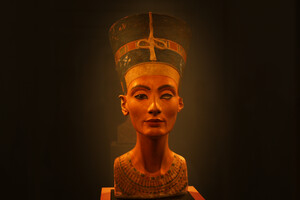At the moment, the researcher is preparing the exhibition “Daughters of the Nile”.

Egyptian archaeologist Zahi Hawass believes that the mummy, which he is currently studying may turn out to be Queen Nefertiti's mummy, Newsweek reports. At the moment, the historian of ancient Egypt, who in the past held the position of secretary general of the country's Supreme Council of Antiquities, is preparing the exhibition “Daughters of the Nile”, dedicated to the women of Egypt during the reign of the pharaohs.
“I am sure that I will be able to present the mummy of Nefertiti in a month or two,” Hawass said.
Also read: Egyptologists call for return of Rosetta Stone and Nefertiti bust: Details of claims to Louvre
Nefertiti, whose full name was Nefernefruaton Nefertiti, lived approximately between 1370 and 1330 BC. She was the wife of Pharaoh Akhenaten, the queen of Ancient Egypt, and the stepmother or mother-in-law of Pharaoh Tutankhamun.
Some scholars believe that after Akhenaten's death, Nefertiti ruled as queen. Others do not agree with this. Hawass adheres to the first assumption.
“I am still looking for two things: Nefertiti's tomb and her body. I really believe that Nefertiti ruled Egypt for three years after Akhenaten's death under the name of Smenkhkar,” the scientist said.
Researchers have already managed to find the mummified remains of some pharaohs and other important figures of Ancient Egypt. But Nefertiti's remains have yet to be found.
“We already have DNA from 18th Dynasty mummies, from Akhenaten to Amenhotep II or III, and there are two unnamed mummies labeled KV21a and b. In October, we will be able to announce the discovery of the mummy of Ankhesenamun, Tutankhamun's wife, and her mother Nefertiti. There is also a mummy of a 10-year-old boy in tomb KV35. If this child is the brother of Tutankhamun and the son of Akhenaten, the problem posed to Nefertiti will be solved. I'm sure I can find out which of the two nameless mummies belongs to Nefertiti,” Hawass said.
Despite the fact that excavations in Egypt have been underway for more than 100 years, researchers believe they were able to discover 30 % of what is underground. “Modern Egypt is built on the ancient one. Therefore, the legacy that remains hidden is huge,” Khavass emphasized. However, he believes that some treasures of Ancient Egypt were lost before researchers had the opportunity to discover them.
Hawass believes that the main threat to the ancient heritage is climate change. According to the scientist, if the tombs of the Valley of the Kings are not protected now, they may disappear in a century.
Related video
Earlier archaeologists said that they probably managed to find the tomb of Nefertiti. By with the help of ground-penetrating radar, they discovered a void in Tutankhamun's burial, which, as it is believed, may contain the queen's tomb. At the same time, final confirmation of this assumption was never received.




